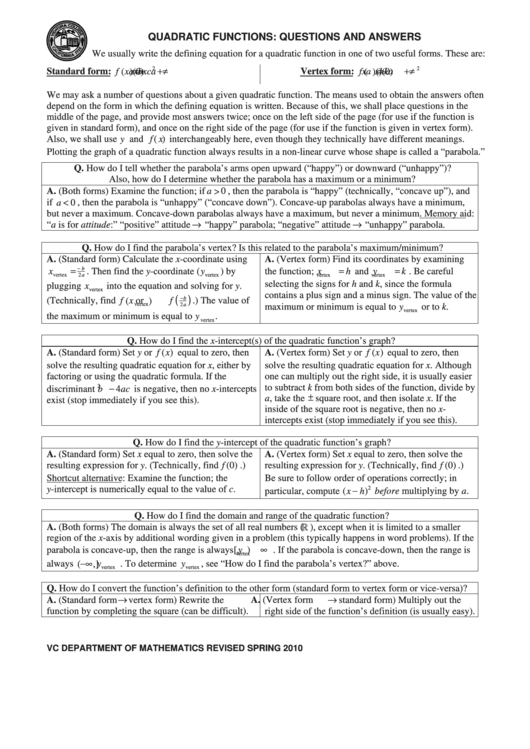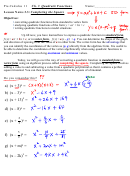Quadratic Functions Questions And Answers
ADVERTISEMENT
QUADRATIC FUNCTIONS: QUESTIONS AND ANSWERS
We usually write the defining equation for a quadratic function in one of two useful forms. These are:
=
+
+
≠
=
−
+
≠
2
2
Standard form:
f x
( )
ax
bx c
(
a
0)
Vertex form:
f x
( )
a x h
(
)
k
(
a
0)
We may ask a number of questions about a given quadratic function. The means used to obtain the answers often
depend on the form in which the defining equation is written. Because of this, we shall place questions in the
middle of the page, and provide most answers twice; once on the left side of the page (for use if the function is
given in standard form), and once on the right side of the page (for use if the function is given in vertex form).
Also, we shall use y and
f x interchangeably here, even though they technically have different meanings.
( )
Plotting the graph of a quadratic function always results in a non-linear curve whose shape is called a “parabola.”
Q. How do I tell whether the parabola’s arms open upward (“happy”) or downward (“unhappy”)?
Also, how do I determine whether the parabola has a maximum or a minimum?
a > , then the parabola is “happy” (technically, “concave up”), and
A. (Both forms) Examine the function; if
0
a < , then the parabola is “unhappy” (“concave down”). Concave-up parabolas always have a minimum,
if
0
but never a maximum. Concave-down parabolas always have a maximum, but never a minimum. Memory aid:
“ a is for attitude :” “positive” attitude → “happy” parabola; “negative” attitude → “unhappy” parabola.
Q. How do I find the parabola’s vertex? Is this related to the parabola’s maximum/minimum?
A. (Standard form) Calculate the x -coordinate using
A. (Vertex form) Find its coordinates by examining
=
=
= . Be careful
−
b
x
. Then find the y -coordinate (
y
) by
the function;
x
h
and
y
k
vertex
2
a
vertex
vertex
vertex
selecting the signs for h and k, since the formula
plugging
x
into the equation and solving for y .
vertex
( )
contains a plus sign and a minus sign. The value of the
−
b
(Technically, find
f x
(
)
or
f
.) The value of
vertex
2
a
maximum or minimum is equal to
y
or to k.
vertex
the maximum or minimum is equal to
y
.
vertex
Q. How do I find the x-intercept(s) of the quadratic function’s graph?
A. (Standard form) Set y or
f x equal to zero, then
( )
A. (Vertex form) Set y or
f x equal to zero, then
( )
solve the resulting quadratic equation for x, either by
solve the resulting quadratic equation for x. Although
factoring or using the quadratic formula. If the
one can multiply out the right side, it is usually easier
−
2
to subtract k from both sides of the function, divide by
discriminant
b
4
ac
is negative, then no x-intercepts
a, take the ± square root, and then isolate x. If the
exist (stop immediately if you see this).
inside of the square root is negative, then no x-
intercepts exist (stop immediately if you see this).
Q. How do I find the y-intercept of the quadratic function’s graph?
A. (Standard form) Set x equal to zero, then solve the
A. (Vertex form) Set x equal to zero, then solve the
resulting expression for y. (Technically, find
f
(0)
.)
resulting expression for y. (Technically, find
f
(0)
.)
Shortcut alternative: Examine the function; the
Be sure to follow order of operations correctly; in
−
y-intercept is numerically equal to the value of c.
2
particular, compute
(
x h
)
before multiplying by a.
Q. How do I find the domain and range of the quadratic function?
A. (Both forms) The domain is always the set of all real numbers ( ℝ ), except when it is limited to a smaller
region of the x-axis by additional wording given in a problem (this typically happens in word problems). If the
∞ . If the parabola is concave-down, then the range is
parabola is concave-up, then the range is always
[
y
, )
vertex
−∞
always
(
,
y
]
. To determine
y
, see “How do I find the parabola’s vertex?” above.
vertex
vertex
Q. How do I convert the function’s definition to the other form (standard form to vertex form or vice-versa)?
A. (Standard form → vertex form) Rewrite the
A. (Vertex form → standard form) Multiply out the
function by completing the square (can be difficult).
right side of the function’s definition (is usually easy).
VC DEPARTMENT OF MATHEMATICS
REVISED SPRING 2010
ADVERTISEMENT
0 votes
Related Articles
Related forms
Related Categories
Parent category: Education
 1
1








